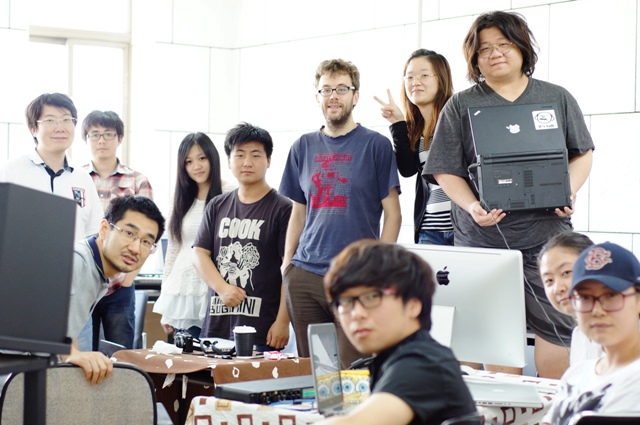
| SYCOM News | Sound Director Curriculum | EA Composition Curriculum | Max/MSP Workshop | Go Back Homepage |
Max/MSP Workshop June 2013

| Day 1 |
* Schedule: 10:00 - 12:00 Morning Session Day 1 - Foundations of Max AIM: developing confidence in using Max/MSP - opening presentation FOUNDATIONS: |
| Download |
| Drum Sequencer |

| Day 2 |
* Schedule AM: - Recap of Techniques from Yesterday - BEGINNER GROUP: - ADVANCED GROUP: design a collaborative sequencer PM: - ADVANCED GROUP: sequencer testing - recap of techniques, goals for tomorrow * The Big Picture 1. BEGINNERS: Build a Trigger-able Performance Instrument a. basic requirements - INPUT: a trigger input, and three 'continuous control' inputs b. advanced possibilities - live microphone input c. individuality - each instrument should sound different STAGES: - no GUI, no graphical objects 2. ADVANCED USERS: Design and Build a Collaborative Sequencer a. DESIGN STAGE: Discuss and produce a specification for the design: - What will the basic form of the sequencer be? What features do we want to have? b. BUILD STAGE: - build a prototype on a single machine, reflect on the basic design * Three Object Challenge 1. Build a sound-making patch using three main objects and ~ezdac Examples: Real world: 2. Share and extend - share each of your patches and try to combine them |
| Download |
| Drum Sequencer - Synthesis and Sampled Sounds |

| Day 3 |
* Schedule AM: BEGINNER GROUP: - complete your instruments! INSTRUMENTS to do: - graphical objects and presentation mode ADVANCED GROUP: - PM: - samples * simple MASTER/SLAVE sequencer test - give each player a number |
| Download |

| Day 4 |
Extensions and Viewpoints - developing individual projects Max Basics Quiz 01. Message Order (click for download patch)
Create a simple decay envelope using line~ and use it to control a cycle~ object Show the result of the envelope in the scope Smooth the envelope to avoid clicks
b. Convert the output of the dial to produce a tone in Hz that can cover the full frequency spectrum
|
| P.S. |
--In order to be successful in the final assignment, you will need to be able to: --To do this we will use subpatches, abstractions and bpatchers. --In addition, flexible signal routing is possible using matrix~ and matrixctrl We will look at all these elements in the following task... |
| Download |
| Patch (Modularity and Resuability in Max) |